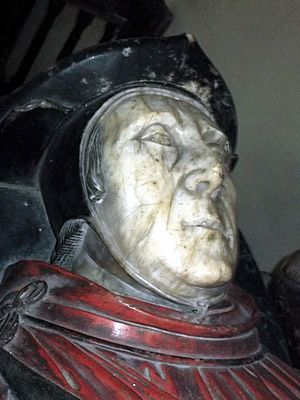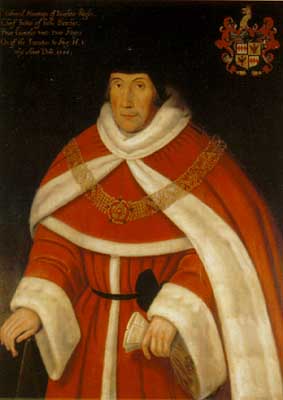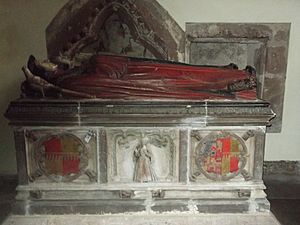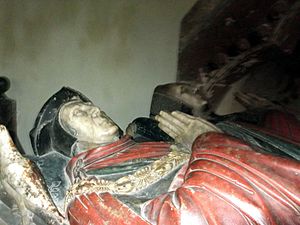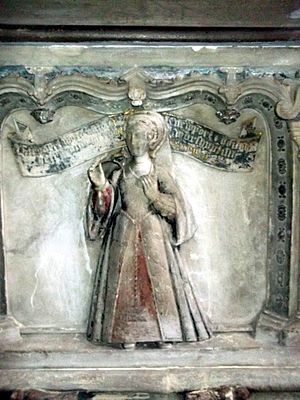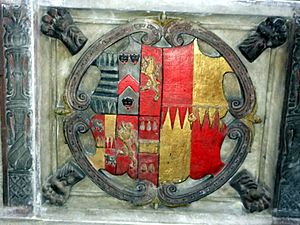Thomas Bromley (chief justice) facts for kids
Sir Thomas Bromley (died 1555) was an important English judge from Shropshire. He became famous during a time of big changes in England, known as the Mid-Tudor period. He held important legal jobs in the Welsh Marches (the border area between England and Wales).
King Henry VIII liked him, and he was part of the group that helped rule England when Edward VI was a young king. Later, Queen Mary I made him the Chief Justice of the King's Bench, which was a very high legal position.
Contents
Family History
Thomas Bromley came from a well-known family in Shropshire. His family originally came from Eccleshall in Staffordshire. They gained land by marrying into other families. In the 1400s, Thomas's grandfather married a wealthy woman from Malpas, Cheshire.
Many Bromleys became lawyers and politicians in the 1500s. Thomas's cousin, George, was a respected lawyer. The famous Lord Chancellor, Sir Thomas Bromley (1530–1587), and Sir George Bromley (c.1526–89), a judge in Chester, were also related to him.
Thomas Bromley was born in the early 1500s, likely in Shropshire. He was the second son of:
- Roger Bromley, who was the third son of Roger Bromley of Mitley, Shropshire.
- Jane Jennings, daughter of Thomas Jennings of Walliborne Hall, Church Pulverbatch.
The Bromley Family Tree
This family tree shows how the Bromley politicians and lawyers were connected in the 1500s. It also shows their links to the Hill, Corbet, and Newport families.
| David Browe of Malpas, Cheshire | Jane Mitley | Roger Bromley of Mitley | |||||||||||||||||||||||||||||||||||||||||||||||||||||||||||||||||||||||||||||||||||||||||||||
| Humphrey Hill of Blore and Buntingsdale | Agnes, daughter and coheiress of John Bird of Charlton, Shropshire, granddaughter and heiress of David of Malpas | Unknown, daughter and coheiress of David Browe | Roger Bromley of Mitley | ||||||||||||||||||||||||||||||||||||||||||||||||||||||||||||||||||||||||||||||||||||||||||||
| Thomas Hill | Margaret Wilbraham of Woodhey, near Faddiley, Cheshire | Beatrix Hill | William Bromley of Mitley | Roger Bromley | Jane Jennings of Walliborne Hall, Church Pulverbatch | ||||||||||||||||||||||||||||||||||||||||||||||||||||||||||||||||||||||||||||||||||||||||||
| Sir Rowland Hill (died 1561), of London and Hodnet, Lord Mayor of London | Joanna Hill | John Gratewood | George Bromley of Hodnet, High Sheriff of Shropshire 1521-2 | Jane Lacon of Willey, Shropshire | William Bromley | Elizabeth Dodd of Cloverley, near Calverhall, Shropshire | THOMAS BROMLEY (died 1555) of Eyton on Severn, Wroxeter and Shrewsbury, Chief Justice of the Queen's Bench | Isabel Lyster of Rowton, Shropshire | |||||||||||||||||||||||||||||||||||||||||||||||||||||||||||||||||||||||||||||||||||||||
| Reginald Corbet (died 1566) of Adderley and Stoke upon Tern, MP for Much Wenlock and Shrewsbury, Justice of the King's Bench | Alice Gratewood, co-heiress of Sir Rowland Hill | Thomas Bromley (1530–87), of Rodd Castle and Hodnet, MP for Bridgnorth, Wigan and Guildford, Lord Chancellor | Elizabeth Fortescue of Shirburn, Oxfordshire | Sir George Bromley (c.1526–89), of Hallon in Worfield, MP for Much Wenlock, Liskeard and Shropshire | Joanne Waverton of Worfield | Margaret Bromley | Sir Richard Newport (died 1570) of High Ercall, MP for Shropshire | ||||||||||||||||||||||||||||||||||||||||||||||||||||||||||||||||||||||||||||||||||||||||
| Richard Corbet | Anne Bromley | Elizabeth Bromley | Sir Oliver Cromwell (died 1655) of Hinchingbrooke House and Ramsey Abbey, MP for Huntingdonshire | Sir Henry Bromley (c.1560–1615), of Holt Castle and Shrawardine Castle, MP for Plymouth, Worcestershire and Shropshire | Elizabeth Pelham | Francis Bromley (c.1556–91), of Hodnet, MP for Shropshire | Sir Edward Bromley (1563–1626), of Shifnall Grange and Bridgnorth, Baron of the Exchequer, MP for Bridgnorth | Francis Newport, MP for Shropshire | |||||||||||||||||||||||||||||||||||||||||||||||||||||||||||||||||||||||||||||||||||||||
| Sir John Corbet, 1st Baronet, of Stoke upon Tern, MP for Shropshire, prominent Presbyterian and Parliamentarian | Thomas Bromley, MP for Worcestershire | Richard Newport, 1st Baron Newport, MP for Shropshire, prominent Royalist | |||||||||||||||||||||||||||||||||||||||||||||||||||||||||||||||||||||||||||||||||||||||||||||
Legal Training and Early Career
The Bromley family was already involved in law. Thomas's older cousin, George Bromley, was an important member of the Inner Temple, one of the main law schools in London.
Thomas Bromley's own legal journey began in May 1519. He was briefly suspended from the Inner Temple for bad behavior. He had to promise to follow the rules and pay his fees. Despite this early trouble, he quickly gained trust at the Inn.
In 1526, he helped manage building projects. In 1528, he became an auditor for the Treasurer of the Inner Temple. By May 1533, he was chosen as a "Reader," which meant he would give lectures to other lawyers. In June 1539, King Henry VIII made him a serjeant-at-law, a very senior lawyer. He was supposed to be a Reader again, but he refused and was fined. However, this record was later crossed out. He was appointed Reader again in November 1539 but couldn't finish his lectures due to a "debility," meaning he was unwell.
A Career in Law and Politics
While studying law, Thomas Bromley also built his political career.
Serving in Parliament
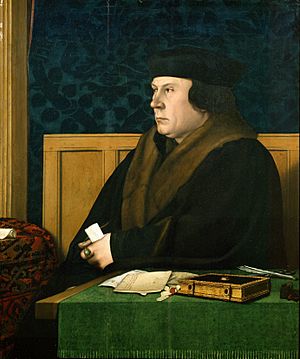
It's likely that Bromley was a Member of Parliament (MP) in the English Reformation Parliament from 1529 to 1536. An MP is a person elected to represent a group of people in the House of Commons. A list made by Thomas Cromwell, a powerful minister to Henry VIII, shows Bromley's name. This list likely included people who might oppose the King's break from the Pope. Bromley's presence on this list suggests he didn't always agree with Cromwell. His exact constituency (the area he represented) is unknown.
Building Power in Shropshire
Parliament wasn't the only place Bromley gained influence. His home county of Shropshire offered many chances. The local gentry (landowners) held much power there, especially in the town of Shrewsbury.
Thomas Bromley became a "freeman" of Shrewsbury in 1528, which gave him special rights. He also joined the Drapers' Company of Shrewsbury, one of the two main trade guilds in the town. Around 1532, he became a Warden of this company and an alderman, a member of the town council. He held this council position until he died. In 1536, he became a Justice of the Peace (JP) in Shropshire, helping to keep law and order. By 1537, he was the "Recorder" of Shrewsbury, the town's chief legal officer. This job meant he had to represent Shrewsbury's interests in London, which fit well with his work at the Inner Temple.
Bromley was good friends with Rowland Hill, who was a very successful merchant in London and later became the first Protestant Lord Mayor of London. Hill bought a lot of land in Shropshire that became available after the dissolution of the monasteries (when monasteries were closed down). Bromley also bought some of this land, including property at Wroxeter, which became his main home. He bought Eyton on Severn and Aston, which used to belong to Shrewsbury Abbey.
As Bromley became more important nationally, he strengthened his power locally. He became a Justice of the Peace in other nearby counties like Gloucestershire, Worcestershire, and Herefordshire. When Edward VI became king, Bromley's role was so important that he gave up his Recorder job in Shrewsbury to Reginald Corbet. By this time, he was the Custos Rotulorum of Shropshire, the most senior civil officer in the county. By 1552, he joined the Council in the Marches, which was the central government's representative in Wales and the border areas.
Rising in the Courts
From 1534, Bromley was a "Justice in Eyre" for South Wales, meaning he traveled to hear cases. Rowland Lee, the Bishop of Coventry and Lichfield, was the head of the Council in the Marches of Wales. Lee wanted to stop corruption and improve justice. He saw Bromley as an ally and recommended him for promotion to Thomas Cromwell. However, Cromwell didn't support Bromley, so his career really took off after Cromwell lost power.
Bromley officially became a serjeant-at-law in 1540. Another lawyer, William Coningsby, who also had problems with Cromwell, was honored at the same time. They had a special farewell ceremony at the Inner Temple.
Soon after, Bromley was promoted to "King's Serjeant" in November 1540. He became a Justice of the Peace in many more counties, showing his growing importance. On November 4, 1544, he became a judge of the King's Bench.
Years of Influence
King Henry VIII liked Bromley and even named him as one of the people to carry out his will, leaving him £300. This meant Bromley was part of the council that ruled when Edward VI was young, and he was a Privy Counsellor (a royal advisor).
However, near the end of Edward VI's reign, Bromley got involved in a plan by Northumberland to make Lady Jane Grey queen instead of Mary. Northumberland gathered important judges, including Bromley, and told them the king wanted Lady Jane to be queen. The judges said this would be against the law and could be seen as treason. Northumberland became very angry and scary. To avoid danger, Bromley and the other judges agreed to prepare the legal document, but Bromley cleverly avoided actually signing it.
Because of this, when Mary became queen, she sent the old chief justice to prison. But she made Thomas Bromley the Chief Justice of the King's Bench on October 4, 1553. Some historians thought Bromley was secretly Catholic, but more recent research suggests he was not.
Later Years and Death
Bromley oversaw the trials of people involved in Wyatt's rebellion, a revolt against Queen Mary. During one trial, he allowed the accused, Sir Nicholas Throckmorton, unusual freedom to speak. However, Bromley was not always fair. He refused to let the prisoner call a witness and didn't let him see a law he needed. Despite this, the prisoner was found not guilty, which made Queen Mary very angry, and the jury was punished.
Sir William Portman took over as chief justice on June 11, 1555. For a long time, people thought Bromley might have been removed from his job because the Queen was unhappy with him. However, we now know that Bromley died about four weeks before Portman took over, meaning he was not dismissed.
Death and Burial
Thomas Bromley died on May 15, 1555. In his will, written in 1552, he named his wife and his friend Rowland Hill (a known Protestant) as executors. He expressed his faith in God. His will did not contain any specific Catholic instructions, which goes against the idea that he was secretly Catholic. He left money to help the poor in Shrewsbury and nearby areas. He also left a small gift to Rowland Hill as a sign of their "old love and friendship." He left 40 shillings a year for ten years to the young Thomas Bromley (who would become Lord Chancellor) if he continued his law studies. The rest of his property was divided between his wife and daughter.
Bromley was buried in St Andrew's Church in Wroxeter. A beautiful stone monument was built there, showing him in his judge's robes next to his wife.
Marriage and Family
Some records say Elizabeth Dodd was Bromley's first wife. She was the daughter of John Dodd of Chorley (also called Cloverley in Shropshire). We don't know much about this marriage, and some sources even question if it happened.
By 1526, he was married to Isabel Lyster (or Lister), daughter of Richard Lyster of Rowton, Shropshire. She outlived him and was one of the people who carried out his will. She inherited half of his remaining property. Thomas and Isabel Bromley had one daughter named Margaret. Since they had no sons, most of Bromley's property eventually went to Margaret.
Descendants
Margaret Bromley married Sir Richard Newport, an important landowner whose home was near Wroxeter. Margaret and Richard Newport had four sons (two died young) and three or four daughters.
- Sir Francis Newport, their oldest son, had a son named:
* Richard Newport, 1st Baron Newport, who was given his title by King Charles I for his financial support during the English Civil War. His heir was: * Francis Newport, 1st Earl of Bradford, who was important in supporting King Charles II. Through him, Thomas Bromley became an ancestor of later Earls of Bradford.
- Andrew Newport, the fourth son, was an MP for Shrewsbury.
- Isabel Newport married Sir Charles Foxe.
- Elizabeth Newport married Francis Lawley, and their family line led to the Lawley baronets.
- Magdalen Newport married Richard Herbert and was the mother of the famous poet George Herbert.
Family Tree of Descendants
This family tree shows the main descendants of Thomas Bromley and Isabel Lyster through their daughter Margaret.
| Elizabeth Dodd of Cloverley, near Calverhall, Shropshire | THOMAS BROMLEY (died 1555) of Eyton on Severn, Wroxeter and Shrewsbury, Chief Justice of the Queen's Bench | Isabel Lyster of Rowton, Shropshire | |||||||||||||||||||||||||||||||||||||||||||||||||||||||
| Margaret Bromley | Sir Richard Newport (died 1570) of High Ercall, MP for Shropshire | ||||||||||||||||||||||||||||||||||||||||||||||||||||||||
| Francis Newport, MP for Shropshire | Beatrice Lacon of Willey, Shropshire | Isabel Newport | Sir Charles Foxe | Magdalen Newport | Richard Herbert (died 1596), MP for Montgomery Boroughs and Montgomeryshire | ||||||||||||||||||||||||||||||||||||||||||||||||||||
| Andrew Newport, MP for Shrewsbury | Francis Lawley of Spoonhill | Elizabeth Newport | Thomas Lawley (1547–1621) of Much Wenlock, MP for Much Wenlock | ||||||||||||||||||||||||||||||||||||||||||||||||||||||
| Richard Newport, 1st Baron Newport (1587–1651), MP for Shropshire, prominent Royalist | Rachel Leveson, daughter of Sir John Leveson | Sir Thomas Lawley, 1st Baronet (died 1646), of London, Twickenham, and Spoonhill, MP for Much Wenlock | Anne Manning, daughter and coheiress of John Manning of Hackney | Sir Edward Lawley (1586–1623) of Much Wenlock and St. Giles-in-the-Fields, Middlesex, MP for Much Wenlock | |||||||||||||||||||||||||||||||||||||||||||||||||||||
| Andrew Newport (1622–99), MP for Montgomeryshire, Preston and Shrewsbury | Sir Francis Lawley, 2nd Baronet | Anne Whitmore, daughter of Sir Thomas Whitmore, 1st Baronet of Apley | George Herbert (1593–1633), poet and clergyman | ||||||||||||||||||||||||||||||||||||||||||||||||||||||
| Francis Newport, 1st Earl of Bradford (1620–1708) | Diana Russell, daughter of Francis Russell, 4th Earl of Bedford | Beatrice Newport | Henry Bromley of Holt Castle | Edward Herbert, 1st Baron Herbert of Cherbury (1582–1648), MP for Montgomeryshire and Merioneth | Mary Herbert | Henry Herbert (1595–1673), Master of the Revels | |||||||||||||||||||||||||||||||||||||||||||||||||||
| Earls of Bradford | Henry Bromley (1632–70) of Holt Castle, MP for Worcestershire | Lawley Baronets and Barons Wenlock | Barons Herbert of Chirbury, first creation | Barons Herbert of Chirbury, second creation | |||||||||||||||||||||||||||||||||||||||||||||||||||||


